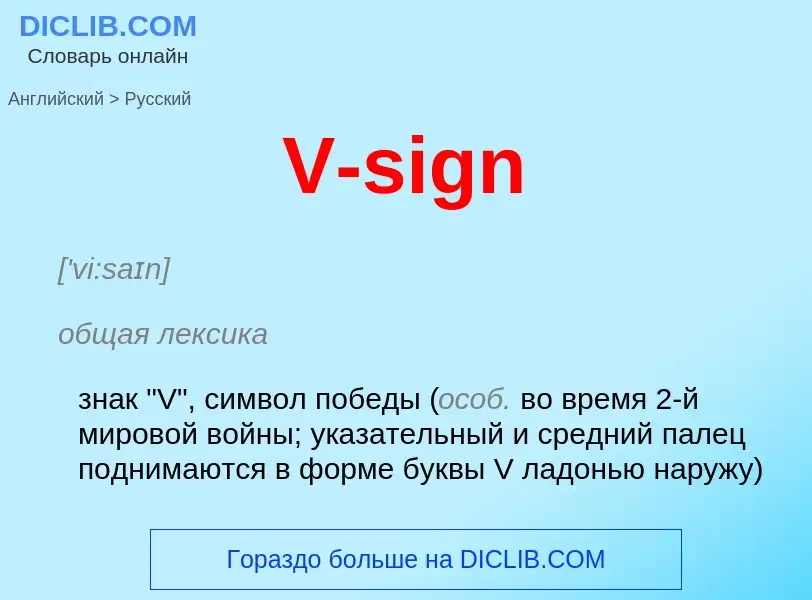Перевод и анализ слов искусственным интеллектом ChatGPT
На этой странице Вы можете получить подробный анализ слова или словосочетания, произведенный с помощью лучшей на сегодняшний день технологии искусственного интеллекта:
- как употребляется слово
- частота употребления
- используется оно чаще в устной или письменной речи
- варианты перевода слова
- примеры употребления (несколько фраз с переводом)
- этимология
V-sign - перевод на Английский
['vi:saɪn]
общая лексика
знак "V", символ победы (особ. во время 2-й мировой войны; указательный и средний палец поднимаются в форме буквы V ладонью наружу)
V от victory - победа
знак "V", . кукиш (грубый жест, выражающий презрение; указательный и средний палец поднимаются в форме буквы V ладонью внутрь)
существительное
общая лексика
знак победы или надежды на победу
знак одобрения (жест поднятыми в виде буквы V указательным и средним пальцами, ладонью вперёд)
знак неодобрения или возмущения (такой же знак, но ладонью назад)
знак победы
Определение
Википедия

The V sign is a hand gesture in which the index and middle fingers are raised and parted to make a V shape while the other fingers are clenched. It has various meanings, depending on the circumstances and how it is presented.
When displayed with the palm inward toward the signer, it can be an offensive gesture in some Commonwealth nations (not dissimilar to showing the middle finger), dating back to at least 1900. When given with the palm outward, it is to be read as a victory sign ("V for Victory"); this usage was introduced in January 1941 as part of a campaign by the Allies of World War II, and made more widely known by Winston Churchill. During the Vietnam War, in the 1960s, the "V sign" with palm outward was widely adopted by the counterculture as a symbol of peace and still today in the United States it is commonly called the "peace sign". Shortly thereafter, it also became a gesture associated with fun used in photographs, especially in East Asia, where the gesture is also associated with cuteness.



![Young Japanese women giving V gesture in [[Ikebukuro]] (2010) Young Japanese women giving V gesture in [[Ikebukuro]] (2010)](https://commons.wikimedia.org/wiki/Special:FilePath/Amusement Girls 2.jpg?width=200)
![[[Winston Churchill]], British prime minister, giving a V sign in 1943 [[Winston Churchill]], British prime minister, giving a V sign in 1943](https://commons.wikimedia.org/wiki/Special:FilePath/Churchill V sign HU 55521.jpg?width=200)
![US president [[Richard Nixon]] using the gesture as a he boards [[Marine One]] after his resignation in 1974. US president [[Richard Nixon]] using the gesture as a he boards [[Marine One]] after his resignation in 1974.](https://commons.wikimedia.org/wiki/Special:FilePath/President Richard Nixon Departing the White House on the Presidential Helicopter for the Last Time as President.jpg?width=200)
![paparazzo]] photographer in London in 2000 paparazzo]] photographer in London in 2000](https://commons.wikimedia.org/wiki/Special:FilePath/Robbie paparazzi V sign.jpg?width=200)
![drunk driving]] (1972) drunk driving]] (1972)](https://commons.wikimedia.org/wiki/Special:FilePath/Steve McQueen.jpg?width=200)
![''Turning the Regs Around'']] (1973) ''Turning the Regs Around'']] (1973)](https://commons.wikimedia.org/wiki/Special:FilePath/Turning the Regs Around Cover Page.png?width=200)

![royal cipher of King Haakon VII]] royal cipher of King Haakon VII]]](https://commons.wikimedia.org/wiki/Special:FilePath/Håkon 7. malt i veien.jpg?width=200)
![The V-sign (and its Morse code equivalent) incorporated on an American propaganda poster for the [[War Production Board]], 1942 or 1943 The V-sign (and its Morse code equivalent) incorporated on an American propaganda poster for the [[War Production Board]], 1942 or 1943](https://commons.wikimedia.org/wiki/Special:FilePath/V... - Wearing different uniforms but we all have the same big job. Let's go everybody - Keep `em firing. - NARA - 534899.jpg?width=200)
![A German V-sign and slogan on the [[Palais Bourbon]] in occupied [[Paris]]. The banner beneath the "V" reads "Germany is Victorious on All Fronts". A German V-sign and slogan on the [[Palais Bourbon]] in occupied [[Paris]]. The banner beneath the "V" reads "Germany is Victorious on All Fronts".](https://commons.wikimedia.org/wiki/Special:FilePath/Bundesarchiv Bild 183-2004-0216-500, Paris, deutsche Parole am Bourbon-Palast.jpg?width=200)
![Vega]]''. The addition of the date 1945 and a more recent frame has transformed it into a monument. Vega]]''. The addition of the date 1945 and a more recent frame has transformed it into a monument.](https://commons.wikimedia.org/wiki/Special:FilePath/VEGA Royal Square Jersey.jpg?width=200)
![Singer [[Rihanna]] using the V sign, 2011 Singer [[Rihanna]] using the V sign, 2011](https://commons.wikimedia.org/wiki/Special:FilePath/Rihanna, LOUD Tour, Minneapolis 6 crop.jpg?width=200)
![the ''Stardust'' spacecraft]] at the [[Johnson Space Center]] in Texas. the ''Stardust'' spacecraft]] at the [[Johnson Space Center]] in Texas.](https://commons.wikimedia.org/wiki/Special:FilePath/NASA Success.jpg?width=200)
